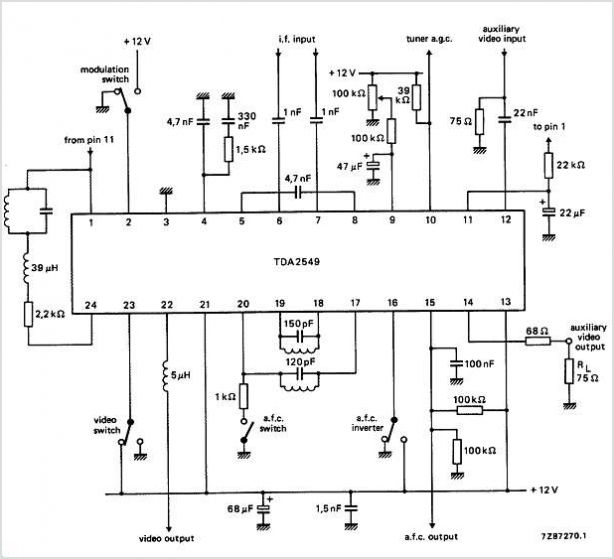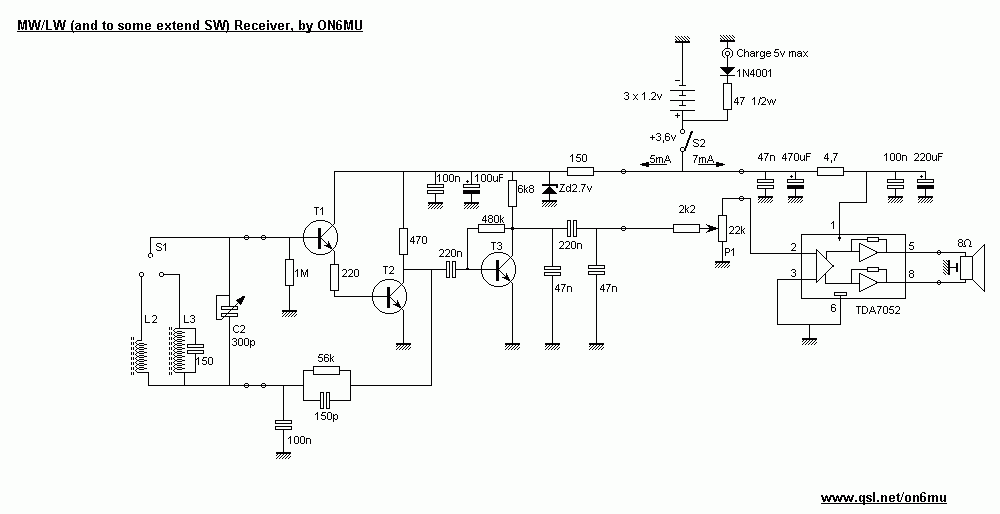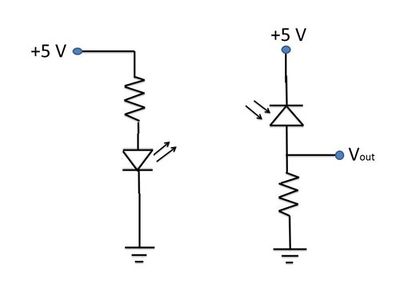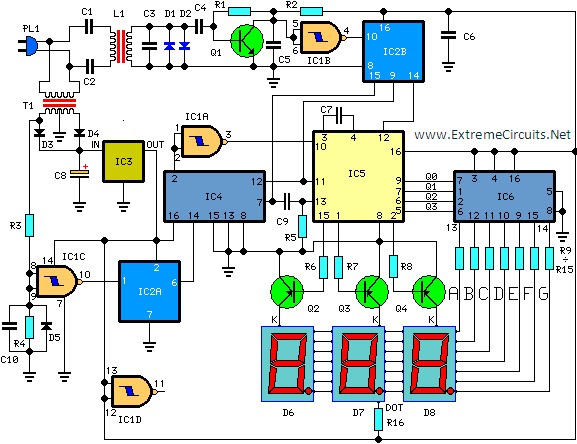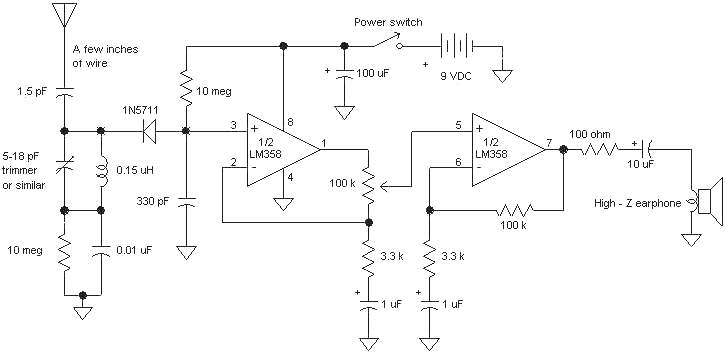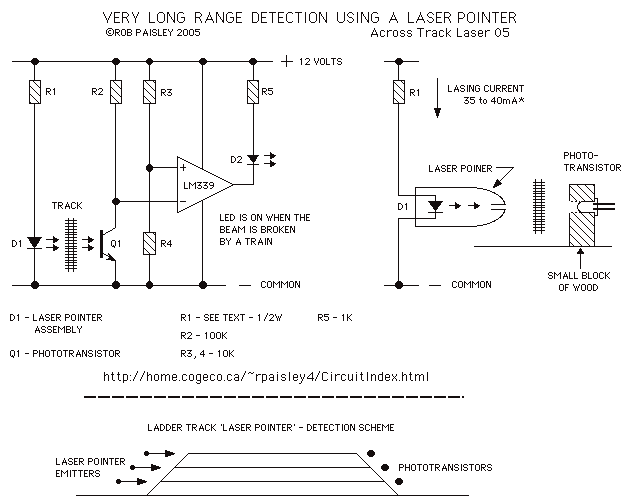
opt301 laser receiver
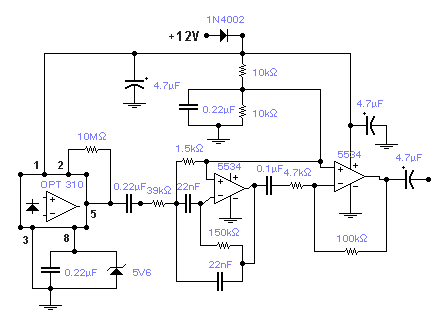
The OPT301 is housed in a TO-99 8-lead package, offering good sensitivity with a bandwidth limited to 4 kHz. Its peak response is in the infrared region at 750 nm, while sensitivity in the visible red spectrum at 670 nm is only slightly reduced. The circuit closely resembles the original receiver, with modifications including a new detector, PCB layout, and improved operational amplifiers. It operates on a single supply voltage of 12 to 13.8 V. The detector features a 10 MΩ feedback resistor directly soldered between pins 2 and 5. The output from the detector is processed by a NE5534 low-noise op-amp (3.4 nV/√Hz), configured as a bandpass filter. A subsequent NE5534 functions as an inverting buffer amplifier with a gain of 20. The entire detector assembly is designed for installation within a compact metal enclosure positioned at the focal point of a lens. The circuit board is designed to be viewed from the top side, while the detector is mounted on the reverse side, where a ground plane made of unetched copper has countersunk holes for the TO-99 package. With a single supply line, the detector's body is maintained at the zener voltage, necessitating isolation from the ground plane and any metal enclosure. To assess the op-amp section, a 600 Ω signal generator was connected to the input of the bandpass filter, and the output from the buffer was measured. The input frequency was varied from 50 Hz to 3 kHz with a constant peak-to-peak voltage of 200 mV. The results indicated a 6 dB bandwidth of only 200 Hz, making the detector particularly suitable for transmitters utilizing modulated continuous wave (CW) signals at a fixed frequency. For transmission, a 4 MHz crystal and a CMOS 4060 oscillator/divider are employed to generate a frequency of 488 Hz. This level of precision allows for the use of a laptop and modern digital signal processing software (e.g., ARGO or Spectran by IK2PHD) to receive signals that are 20 dB below the standard noise level.
The OPT301 circuit design is optimized for applications requiring high sensitivity in the infrared and visible light spectrum, making it suitable for various photodetection tasks. The choice of a TO-99 package not only contributes to its compactness but also enhances thermal stability and mechanical robustness. The use of a single supply voltage simplifies the power management aspect of the design, while the high-value feedback resistor ensures that the detector maintains its sensitivity across the specified wavelengths.
The implementation of the NE5534 op-amps is critical in achieving low noise and high fidelity in signal processing. The first NE5534 configured as a bandpass filter is essential for isolating the desired frequency components from unwanted noise, providing a clear signal for further amplification. The subsequent inverting buffer amplifier increases the signal strength without introducing significant distortion, which is crucial for maintaining the integrity of the received signals.
The mechanical design considerations, such as mounting the detector in a metal enclosure and ensuring proper isolation from the ground plane, are vital for minimizing electromagnetic interference and ensuring consistent performance. The countersunk holes for the TO-99 package facilitate secure mounting and thermal management.
Overall, the OPT301 circuit is tailored for precision applications in photodetection, especially for systems utilizing low-level signals in the presence of noise, making it a valuable component in modern electronic communication and signal processing systems.The OPT301 is in a TO-99 8 lead package and has good sensitivity but a reduced bandwidth of 4kHz. The peak response is just into the Infra Red region at 750nm but its sensitivity in the visible red spectrum at 670nm is only a few percent down. The circuit is almost identical to the original receiver. Changes are the new detector / PCB layout and i mproved op-amps. It uses a single supply at 12 - 13. 8V. The detector has a a 10M Ohm feedback resistor soldered directly betw1een pins 2 and 5. The detector output is followed by a NE5534 low noise op-amp (3. 4nV/Hz) which is configured as a bandpass filter. The final NE5534 is an inverting buffer amplifier with a gain of 20. The complete detector assembly is designed to be mounted in a small metal box at the focal point of a lens. The track is viewed from the top or component side. The detector is fitted to the other side of the board where a groundplane in unetched copper has holes countersunk for the TO-99 package.
With a single supply line the body of the detector is held at the zener voltage. Therefore it should be isolated from the groundplane and from any metal enclosure. To evaluate the op-amp section I connected a 600 Ohm sig gen to the input of the bandpass filter and measured the response at the output of the buffer. The Input was adjusted from 50Hz to 3kHz with a constant level of 200mV Peak to Peak. As you can see from the results below, the 6dB bandwidth is just 200Hz. This makes the detector ideal for transmitters using modulated CW on a fixed frequency. My TX uses a 4MHz crystal and a CMOS 4060 oscillator / divider to generate 488Hz. This degree of accuracy gives the option of using a lap top and modern DSP softw1are (e. g. ARGO or Spectran by IK2PHD) to receive signals 20dB below normal noise level. 🔗 External reference
The OPT301 circuit design is optimized for applications requiring high sensitivity in the infrared and visible light spectrum, making it suitable for various photodetection tasks. The choice of a TO-99 package not only contributes to its compactness but also enhances thermal stability and mechanical robustness. The use of a single supply voltage simplifies the power management aspect of the design, while the high-value feedback resistor ensures that the detector maintains its sensitivity across the specified wavelengths.
The implementation of the NE5534 op-amps is critical in achieving low noise and high fidelity in signal processing. The first NE5534 configured as a bandpass filter is essential for isolating the desired frequency components from unwanted noise, providing a clear signal for further amplification. The subsequent inverting buffer amplifier increases the signal strength without introducing significant distortion, which is crucial for maintaining the integrity of the received signals.
The mechanical design considerations, such as mounting the detector in a metal enclosure and ensuring proper isolation from the ground plane, are vital for minimizing electromagnetic interference and ensuring consistent performance. The countersunk holes for the TO-99 package facilitate secure mounting and thermal management.
Overall, the OPT301 circuit is tailored for precision applications in photodetection, especially for systems utilizing low-level signals in the presence of noise, making it a valuable component in modern electronic communication and signal processing systems.The OPT301 is in a TO-99 8 lead package and has good sensitivity but a reduced bandwidth of 4kHz. The peak response is just into the Infra Red region at 750nm but its sensitivity in the visible red spectrum at 670nm is only a few percent down. The circuit is almost identical to the original receiver. Changes are the new detector / PCB layout and i mproved op-amps. It uses a single supply at 12 - 13. 8V. The detector has a a 10M Ohm feedback resistor soldered directly betw1een pins 2 and 5. The detector output is followed by a NE5534 low noise op-amp (3. 4nV/Hz) which is configured as a bandpass filter. The final NE5534 is an inverting buffer amplifier with a gain of 20. The complete detector assembly is designed to be mounted in a small metal box at the focal point of a lens. The track is viewed from the top or component side. The detector is fitted to the other side of the board where a groundplane in unetched copper has holes countersunk for the TO-99 package.
With a single supply line the body of the detector is held at the zener voltage. Therefore it should be isolated from the groundplane and from any metal enclosure. To evaluate the op-amp section I connected a 600 Ohm sig gen to the input of the bandpass filter and measured the response at the output of the buffer. The Input was adjusted from 50Hz to 3kHz with a constant level of 200mV Peak to Peak. As you can see from the results below, the 6dB bandwidth is just 200Hz. This makes the detector ideal for transmitters using modulated CW on a fixed frequency. My TX uses a 4MHz crystal and a CMOS 4060 oscillator / divider to generate 488Hz. This degree of accuracy gives the option of using a lap top and modern DSP softw1are (e. g. ARGO or Spectran by IK2PHD) to receive signals 20dB below normal noise level. 🔗 External reference
